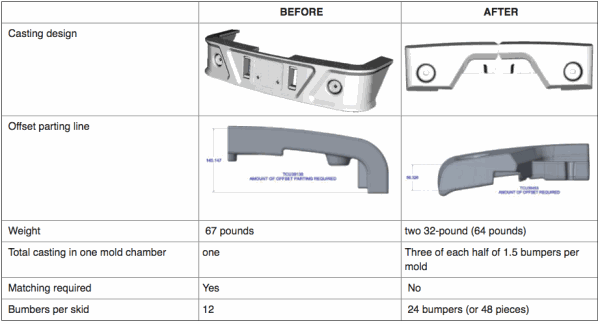Value Analysis and Value Engineering (VA/VE) is an intensive, innovative, and systematic problem-solving process used to drive cost out of our customer's iron castings and improve quality.
Value Analysis / Value Engineering: Collaboration Drives Out Costs
Michael Behring | Waupaca FoundrySometimes a VA/VE initiative also results in improved product performance. That was certainly the case when we collaborated with a global leader in commercial turf and lawn care equipment.
The OEM of a zero-turn commercial mower was seeking ways to reduce cost from a bumper cast in gray iron. What seemed like a straightforward, machined iron casting design was in reality a chance to enhance product performance.
Iron Casting Redesign Opportunities
The OEM identified three key opportunities as follows:
- The original bumper casting design wrapped around the mower, thus displacing the center of gravity. In zero-turn mowers, it is essential that the mass of the rear bumper is properly balanced to provide a counterweight when the mower is operated on inclines. Gray iron provides the needed density, but the distribution of the material was a problem.
- The angle of the original bumper caused it to scrape on inclines and steep grades, a problem for commercial consumers who are trailering the mower to multiple jobsites daily.
- The original bumper casting was designed with a thin section in the center that cracked when/if backed into substantial objects. Customers would then wrestle with removing a broken and costly 67-pound bumper, then order and wait for a replacement part on a machine used for daily service. Downtime meant lost revenue.
Additionally, the one-piece assembly required shipment to a third-party machine shop to drill and tap holes required to mount the bumper to the mower.
Creating Cost Reductions Through Collaboration
Engineering and manufacturing teams at Waupaca Foundry worked collaboratively with the customer's product engineering group to review the production process and collaborate on increasing performance on the part.
Teams at Waupaca Foundry plant identified cost drivers and production solutions to produce the part more efficiently. We then proposed breaking the one-part casting into two parts to better meet the goals and the end user's expectations.
This was not without challenges, however, and our foundry engineers worked to design a gray iron casting that repositioned the offset parting line to allow three halves of the new 2-piece bumper or 1.5 bumpers in each mold.
Additionally, the mounting holes in the 2-piece bumper were redesigned and are now cast without the use of cores versus features requiring a core and/or any secondary machining operations.

A Bumper Crop of Results
The most significant result of the casting redesign was the elimination of the machining required to drill and tap mounting holes. As a result, the customer eliminated shipping and machining costs. The redesign also allowed for shipping more products in a container, thereby reducing transportation costs.
Additionally, the two-part bumper decreased the weight 3%, from 67 pounds to two 32-pound parts without compromising the material needed to achieve balance on the mower. By changing the part's geometry, the center of gravity was redistributed and improved the overall center of gravity of the mower.
The two-piece bumper system is safer and easier (more ergonomic) to handle for assembly and replacement at the factory and the dealership level.
Production efficiency increased due to casting a 2-piece bumper. Casting three parts on a smaller, vertical molding machine allowed for faster production.
Durability was enhanced by eliminating the weak point in the center of the one-piece bumper design, which in turn should reduce warranty claims and the need for costly bumper replacements.
And finally, the issue of scraping the bottom of the bumper during trailer loading and unloading was completely eliminated by reducing the overall profile that existed with the previous design.
VA/VE as a Valuable Team Effort
Proactive design collaboration between Waupaca Foundry and the OEM resulted in an innovative design that redistributed mass, decreased weight, and dramatically streamlined part production—thus improving the product performance for end users.
Through VA/VE and early collaboration, Waupaca Foundry identifies product improvement and cost reduction opportunities for many of our customers. What can we do for you?

